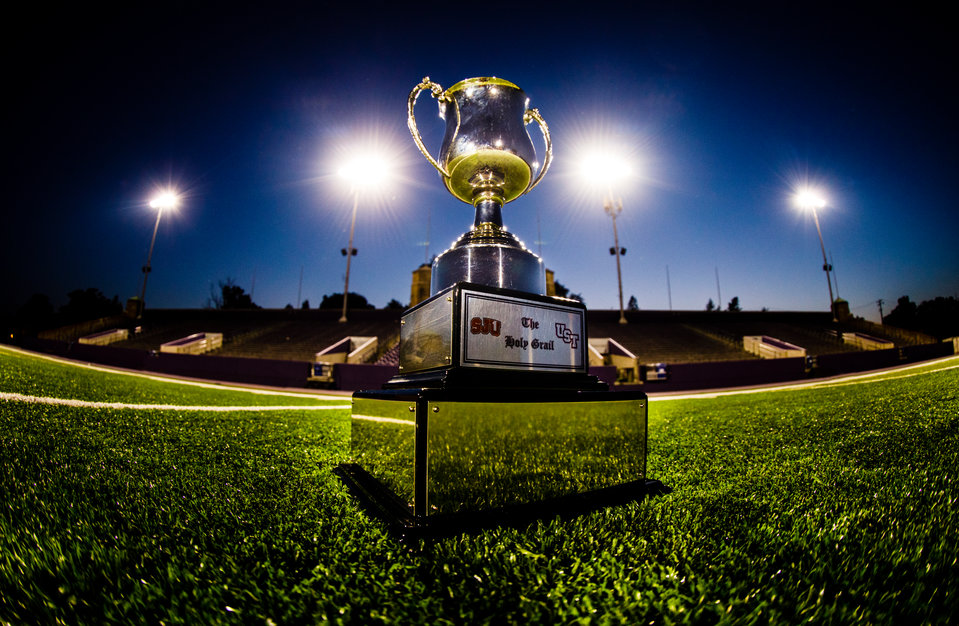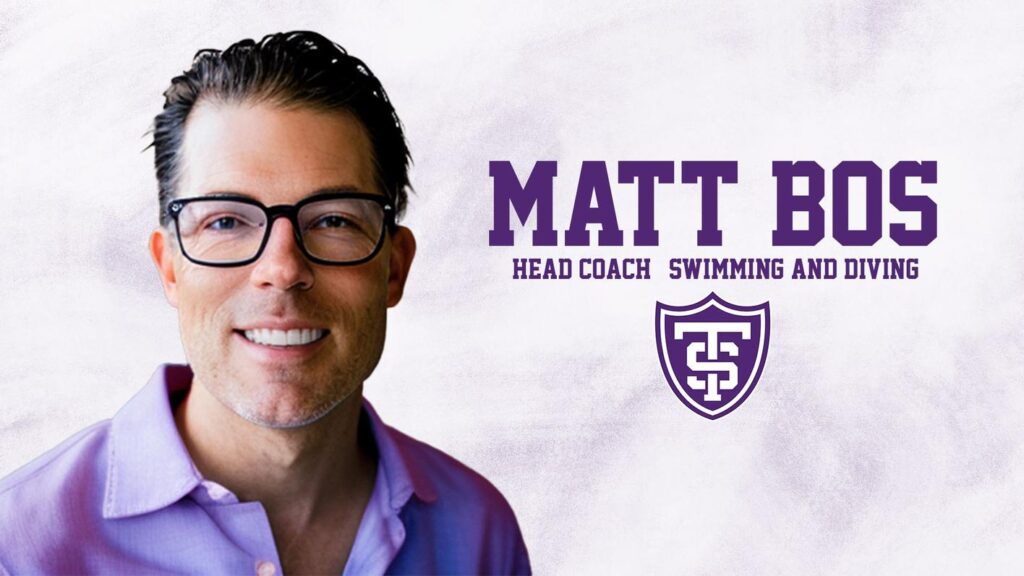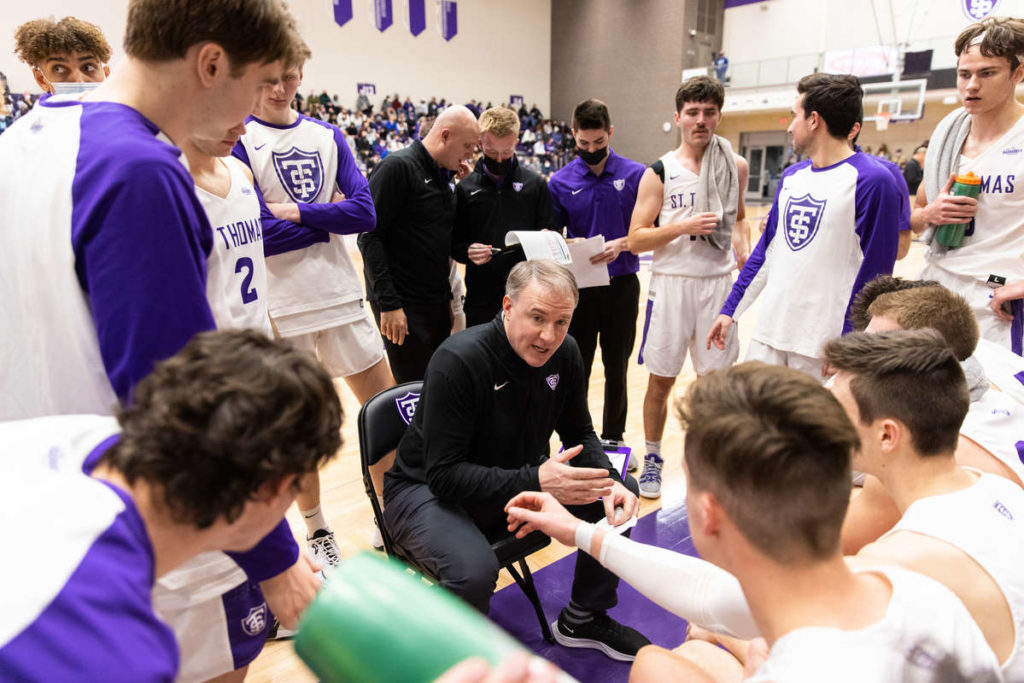The Holy Grail is one of the most storied and enduring items in the western literary tradition, and the trials of those seeking it have made up some of our most recognizable tales. From King Arthur to Indiana Jones, those involved in quests for the grail have become legend.
So it is perhaps no surprise that The Holy Grail has made its way to the center of one of the fiercest rivalries in the Minnesota Intercollegiate Athletic Conference (MIAC) and all of Division III athletics, an annual football clash that has forged many legends of its own: University of St. Thomas vs. St. John’s University.
For the first time in the storied rivalry’s history the quest for The Holy Grail – the 4-foot-high traveling trophy claimed by the winner between the two Catholic universities – makes its way to Target Field on Sept. 23.
“It’s a phenomenal way we can promote and expose the great quality of athletics that our schools have,” said Dan McKane, executive director of the MIAC. “Being able to be at Target Field is such an incredible opportunity; it will bring so much attention to our student athletes and schools.”
McKane – who has been involved with MIAC athletics for more than two decades – can appreciate not only such an incredible venue as Target Field, but of the many trophy/rivalry games that bring so much added intensity and excitement across the conference’s football season. MIAC has six such trophy games, each with a name and story as unique as the rivalries that vie for them each year.
“What it does is add more incentive and motivation to what’s already a big game. Every game in the MIAC means so much, so now you add this additional piece to it,” McKane said. “Every school’s rivalry and how they celebrate this type of rivalry game is great. The uniqueness of how each school handles it, and the history behind each one, whether it’s just a trophy, or a procession down the street, it’s a cool way to celebrate.”
The Holy Grail – St. Thomas vs. St. John’s (2001)
On Thanksgiving morning, Nov. 28, 1901, St. John’s and St. Thomas met in football for the first time at the old Lexington Park in St. Paul. One hundred years later, the St. Thomas All-College Council and the St. John’s Student Senate came together to develop The Holy Grail, which resides with the winning team for the year before the next meeting. The Holy Grail currently resides on the St. Thomas campus in St. Paul.
The Goat – St. Olaf vs. Carleton (1931)
The story of this Northfield-centric rivalry traces back to 1913, when a St. Olaf student made a makeshift goat and hung it from the rafters, trying to “get the goat” of the Carleton players. In 1931 that tradition made its way to the football field, where a wooden goat has since had the score and winning team written on it every year.
In 2003, the annual showdown became known as the “Cereal Bowl” after the local cereal company Malt O’ Meal sponsored the game. Every year huge bowls of Coco Roos, Colossal Crunch and the like feed hungry fans cheering on either side of the rivalry.
The Paint Bucket – Hamline vs. Macalester (1965)
While Macalester no longer plays in the MIAC for football, the conference’s oldest rivalry game continues today with the battle for the Paint Bucket. The teams first played in 1887, and in 1965 Hamline alum Chuck Slocum ’69 helped lead the creation of the Paint Bucket: “At the time, one of the running pranks was players from Hamline and Macalester would spray paint on the other’s campus … It was destructive. So I talked to some of the guys at Macalester, and we decided to do something constructive with it,” Slocum told the Pioneer Press.
The Book of Knowledge (1998) – Carleton vs. Macalester
Long known as two of the “brainier” institutions in the conference, Carleton and Macalester first met on the gridiron in 1898. Exactly 100 years later the Book of Knowledge was introduced to the rivalry game, known most widely as the “Brain Bowl.”
The Troll (1974) – Concordia vs. St. Olaf
Started in 1974, The Troll was developed as a way to welcome St. Olaf back into the conference after a two-decade absence, and tapping into Norse mythology to create a troll made for a fitting, sought-after trophy for the two Norwegian-rooted schools. The Troll’s legend grew in 2013 when ESPN’s College GameDay featured it on the show, dubbing it, “The Ugliest Rivalry Trophy in College Football.”
The Hammer (2005) – Augsburg vs. Hamline
In 2005, Augsburg coach Frank Haege decided to up the ante on the value of the weekly hammer trophy awarded to special teams players, putting possession of it on the line for the winning school of the annual matchup. Special teams coach Greg Flickinger had moved from Augsburg in 2004 to Hamline in 2005, so grappling for the special-teams-trophy-turned-all-important-Hammer was all the more fitting for the Twin Cities' rivals.
More Minnesota College Football Trophy Games (past and present)
Little Brown Jug (1903) – Michigan vs. Minnesota
Under legendary coach Fielding Yost, Michigan had a 28-game win streak end in 1903 with a 6-6 tie at Minnesota. The next morning, Minnesota custodian Oscar Munson carried an earthenware water jug to the office of athletic department boss L. J. Cooke. Munson pronounced in a heavy Scandinavian accent, “Jost left his yug.” The Gophers decided to keep the prize, and painted on its side “Michigan Jug - Captured by Oscar, October 31, 1903,” and the score, “Minnesota 6, Michigan 6.” Yost sent a letter asking Minnesota to return the jug. Cooke wrote back “if you want it, you’ll have to win it.” Michigan won the next meeting and got the little brown jug back in 1909 and a traveling trophy was born. The U of M Gopher athletics website declares it, “The most famous of all college rivalry trophies.”
Floyd of Rosedale (1935) – Iowa vs. Minnesota
Every college football season, Minnesota and Iowa play for “Floyd of Rosedale,” a symbol of how interstate tension can be averted through athletic competition. The Minnesota and Iowa governors proposed a bet with a prize hog going to the winner. The Gophers won the game 13-6, so Minnesota Gov. Floyd Olson won a pig from Rosedale Farms near Fort Dodge, Iowa – and it was dubbed Floyd of Rosedale. The original Floyd was given as the prize in a state-wide essay contest, and later was sold to the University of Minnesota. A breeder from Mabel, Minn. – near the Iowa border – took Floyd where he lived out the rest of his life. A bronze trophy was later created by St. Paul artist Charles Brioschi and is presented to the winner each season.
Paul Bunyon’s Axe (1948) – Wisconsin vs. Minnesota
“Paul Bunyan’s Axe” has the history of a 126-year-old football rivalry emblazoned on its 6-foot long handle with the scores of all the games. From 1930 through the mid-1940s, the teams actually played for the Bacon Slab Trophy. A Minneapolis doctor fashioned a bacon slab out of black walnut to serve as the traveling trophy that he hoped would compare to the well-known “Little Brown Jug.” The “Slab of Bacon” had a football carved on top inscribed with an “M” or “W,” depending on how you held it. The idea was that the winning team would “bring home the bacon.” The Bacon trophy went missing and was replaced in 1948 by an axe. In 1994, the bacon trophy was found when cleaning out an old storage room at the Badgers’ home stadium.
Governor’s Victory Bell (1993) – Penn State vs. Minnesota
Then-acting Governor Mark Singel of Pennsylvania and Gov. Arne Carlson of Minnesota established the Governor’s Victory Bell on Sept. 4, 1993, the date of the first Minnesota-Penn State game. The contest, which took place at PSU’s Beaver Stadium, not only marked the first game between the two teams, but also signified the Nittany Lions’ inaugural conference game. The design of the trophy is a brass bell bearing the Big Ten medallion, suspended from a wooden frame. The plaque features the state seals of Minnesota and Pennsylvania. The Governor’s Victory Bell gives the Gophers four active “trophy” rivalries on its schedule, more than any other college football program in the country.
“Ossie” (1929) – Minnesota Crookston vs. Minnesota Morris
Formally named “Oswald,” a rolling pig on wheels known as Ossie was created when UMC was the Northwest School of Agriculture (NWSA), and the West Central School of Agriculture (WCSA) in Morris, began a relationship of athletic competition in football. In the 1929 inaugural event, during homecoming at Crookston, NWSA was defeated by WCSA, 20-0. “Ossie” resided in Morris for the first year until in the second game, a 19-6 victory in 1930, the traveling trophy was reclaimed by NWSA and went home to Crookston. The dates and scores are engraved within the sides of the wooden icon from the years 1929-1964. Thirty years passed without the teams playing, then in 1994, the institutions made a commitment to share a rivalry, and rekindle a long, but not lost, tradition.
Sledge Trophy (2008) – Winona State vs. Southwest Minnesota State
During the 2008 season, Winona State would name a defensive player of the game and award that player with a sledge hammer. During warm-ups of the Winona vs. Southwest State game on Oct. 4, a Warrior player brought the sledgehammer to midfield while Mustang players looked on. SMSU went on to take a 35-28 victory, snapping the Warriors’ seven-game winning streak in the series. Following the game, SMSU players ran over to the Winona sideline and grabbed the sledge hammer, celebrating the victory at midfield. SMSU later returned the hammer but a rivalry and trophy game was born. The trophy is a 7-foot tall sledge hammer with the team logos of both WSU and SMSU on each side of the trophy.
Battle for the Paddle (2006) – Minnesota State Moorhead vs. University of Mary
The initial gridiron matchup between Northern Sun Conference rivals U-Mary and Minnesota State Moorhead had an extra incentive in 2006 as both schools battled for the Paddle Trophy in this river rivalry game. U-Mary is located on the Missouri River, while MSU Moorhead sits alongside the Red River. The Paddle Trophy was developed by the student governments of the two colleges. The home team’s student body representative will award the Paddle Trophy, which has each school’s logo on opposite sides of the blade, with the score of each game being added to the winning team’s side after the game.
The Hub Cap (2004) – Bemidji State vs. Minnesota-Crookston
Since 2004, these Northern Sun teams have been playing for a traveling trophy, a Hubcap, to signify its Highway 2 rivalry.
The Traveling Training Trophy (1978) – Minnesota State Mankato vs. St. Cloud State
The Traveling Training Kit signifies the rivalry between these institutions, the two longest-tenured Minnesota members of the former North Central Conference who now compete in the Northern Sun Conference. The trophy features a tackle box with the MSU logo on a purple background on one side and the St. Cloud State logo on a red background on the other. The winner of each year’s game takes home the coveted kit. Minnesota State and St. Cloud State have met on the field since 1923, and have played at least once in every season since rekindling the rivalry in 1978.
The Battle Axe (1993) – Bemidji State vs. Moorhead State
Bemidji State and MSU Moorhead have played 84 times in football since 1929. Because of the history ‘The Battle Axe’ trophy was created. The tradition is the second longest running Division II trophy game dating back to 1948.
Gertie the Goose (???) – Minnesota-Duluth vs. Wisconsin-Superior
Minnesota-Duluth played crossborder institution UW-Superior periodically before the Yellowjackets dropped football shortly into the 1992 season. Jim Malosky became UMD head coach in 1958, starting a 40-year career at Duluth where the stadium is now named in his honor. He recalled that sometime around 1963 “people were asking, `Whatever happened to Gertie the Goose?’" Malosky was confused, then one day he happened to look up from his desk and spied the goose on his office shelf. “Hey, that’s what that stupid thing is,” the coach said. “They must have given it to me that first year when I beat them. I guess it didn’t register.”






